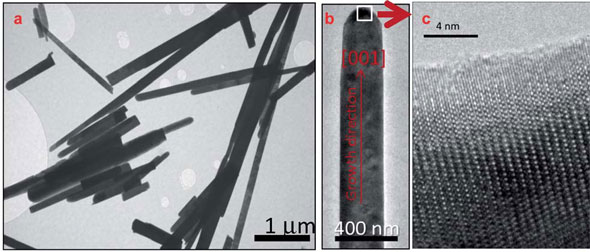| Posted: Aug 27, 2012 | |
Novel nanoparticle synthesis method improves coatings for smart windows |
|
| (Nanowerk Spotlight) Buildings and other man-made structures consume as much as 30-40% of the primary energy in the world, mainly for heating, cooling, ventilation, and lighting. In particular, air conditioners are responsible for a large proportion of the energy usage in the US: 13% in 2006 and 10% in 2020 (projected) of the total primary energy. Air conditioning in China is 40-60% of a building’s energy consumption (the exact figure depends on the area of the building), and overall, accounts for 30% of the total primary energy available. These figures will grow very rapidly with urbanization development. | |
| 'Smart' windows are expected to play a significant role in reducing the energy consumption of homes in two ways: by generating energy themselves (see our Nanowerk Spotlight "Energy-generating smart window"); and by providing better insulation by allowing light in and keeping the heat out (in hot summers) or in (in cold winters). | |
| Near infrared (NIR) light spans the wavelength of 0.76 to 2.5 µm and contains about 47% of the solar energy of light. To reduce the energy consumption of building, one needs to engineer the surface of glass to enhance its thermal insulator property. | |
| "Smart window" is a term that refers to a glass window that allows intelligent control of the amount of light and heat passing though. This control is made possible by an external stimulus such as electrical field (electrochromic), temperature (thermochromic), ultraviolet irradiation (photochromic) and reductive or oxidizing gases (gasochromic). These technologies save energy, address CO2 concerns, improve comfort levels, and have economic benefits. | |
| Vanadium dioxide (VO2) has long been recognized as a a material of significant technological interest for optics and electronics and a promising candidate for making 'smart' windows: it can transition from a transparent semiconductive state at low temperatures, allowing infrared radiation through, to an opaque metallic state at high temperatures, while still allowing visible light to get through. | |
| In a previous Nanowerk Spotlight ("Porosity of nanocoating improves 'smart' window performance ") we reported on a process that can prepare VO2 thin-films with a controllable polymorph and morphology (including grain size and porosity). These results showed that with increased porosity and decreased optical constants the performance of the VO2 films is enhanced, leading to a higher transmittance of visible light and improved solar modulating ability. | |
| In new work, a team led by Yanfeng Gao, a professor at the Shanghai Institute of Ceramics, Chinese Academy of Sciences (SICCAS), has now offered a simple method for promoting the production of monoclinic VO2 nanoparticles by doping. | |
| "Quasi-spherical VO2 nanoparticles with uniform size, controllable polymorph and high crystallinity are ideal functional materials for applications in field-effect transistors, smart window coatings and switches," Gao tells Nanowerk. "However, the synthesis of these VO2 nanoparticles has long been a challenge. In our work, we synthesized crystalline monoclinic VO2 nanoparticles with tunable sizes (8-30 nm) by antimony (Sb3+) doping." | |
 |
|
| (a) TEM images of the VO2 powders prepared by the hydrothermal treatment at 260°C for 12 h without addition of Sb3+; (b) a magnified TEM image of a VO2 (A) rod; (c) the corresponding SAED pattern of the VO2 rod. (© The Royal Society of Chemistry) | |
| Reporting their work in a recent issue of Energy & Environmental Science ("Phase and shape controlled VO2 nanostructures by antimony doping"), the team presents a novel doping strategy for the simultaneous control of the size, morphology and polymorphology of VO2 nanoparticles. The resulting monodispersed nanoparticles are well suited for preparing the flexible foils required for coating smart windows. | |
| Gao explains that VO2 nanoparticles are usually synthesized by high-temperature heating of intermediate vanadium compounds and hydrothermal synthesis. With their novel doping strategy, the researchers were able to synthesize hexagonal-shaped, well crystalline, antimony-doped VO2 nanoparticles with tunable sizes were synthesized via a one-pot hydrothermal method. | |
| "By carefully analyzing the XRD and TEM results, we can get two conclusions" says Gao: "One is that an appropriate amount of Sb3+ dopant can promote the phase transition from VO2 (A) to VO2 (M), and another is that increasing the Sb3+ doping amounts can decrease the particle size." | |
| The researchers point out that their nanoparticles exhibit excellent properties in metal-semiconductor transition and infrared regulation, making them potential materials for application in sensor technologies and the energy-conservation fields. | |
| Gao adds that this novel synthetic strategy, which involves doping of an impurity with a different valence than the matrix cation, might be useful for controlling the solution growth of some technologically important nanomaterials. | |
 By
Michael
Berger
– Michael is author of three books by the Royal Society of Chemistry:
Nano-Society: Pushing the Boundaries of Technology,
Nanotechnology: The Future is Tiny, and
Nanoengineering: The Skills and Tools Making Technology Invisible
Copyright ©
Nanowerk LLC
By
Michael
Berger
– Michael is author of three books by the Royal Society of Chemistry:
Nano-Society: Pushing the Boundaries of Technology,
Nanotechnology: The Future is Tiny, and
Nanoengineering: The Skills and Tools Making Technology Invisible
Copyright ©
Nanowerk LLC
|
|
|
Become a Spotlight guest author! Join our large and growing group of guest contributors. Have you just published a scientific paper or have other exciting developments to share with the nanotechnology community? Here is how to publish on nanowerk.com. |
|
